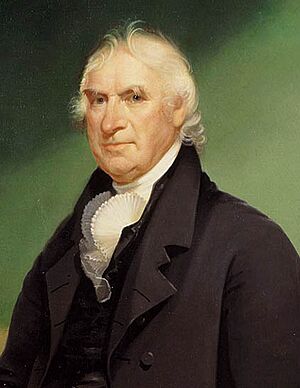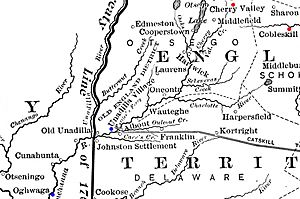Raid on Unadilla and Onaquaga facts for kids
The Raid on Unadilla and Onaquaga was a military operation during the American Revolutionary War. In October 1778, American soldiers and New York militia attacked two Iroquois towns: Unadilla and Onaquaga. These towns were in what is now upstate New York. Over 250 men, led by Lieutenant Colonel William Butler, destroyed the towns. They burned buildings and took or ruined food supplies. This included the people's winter stores.
This raid was a response to earlier attacks. Mohawk chief Joseph Brant and British-supported Loyalists had raided American frontier communities. These raids happened in the spring and summer of 1778. Unadilla is now in the Village of Unadilla, Otsego County. Onaquaga is now in the Town of Windsor, Broome County.
Contents
Why the Raid Happened
After the Battles of Saratoga in October 1777, the British lost a major battle. This changed the American Revolutionary War in upstate New York. It became a "frontier war." British leaders in Quebec helped Loyalist and Native American fighters. They gave them supplies and weapons.
Joseph Brant's Actions
During the winter of 1777–78, Mohawk leader Joseph Brant made plans. He and other Native Americans allied with the British decided to attack frontier settlements. These were in New York and Pennsylvania.
In February 1778, Brant set up a base at Onaquaga (today's Windsor, New York). He gathered many Iroquois and Loyalists. By May, he had between 200 and 300 fighters. One of his goals was to get food for his forces. He also needed supplies for John Butler, who was planning attacks nearby. Brant started his campaign in late May. He raided Cobleskill and other frontier towns all summer.

Planning a Response
Settlers on the frontier found it hard to fight back against these raids. Local militia were helped by some Continental Army soldiers. But these forces usually could not gather fast enough to catch the raiders. The raiders would disappear quickly. Also, the militia had to return to their farms to grow food.
New York Governor George Clinton and militia commander Abraham Ten Broeck thought about attacking the main Iroquois bases. These were Onaquaga and Unadilla. But they didn't organize an expedition until September 17. This was after Brant attacked German Flatts (today's Herkimer).
Governor Clinton asked for help. General George Washington allowed the Continental Army to join the operation. He gave the job to Lieutenant Colonel William Butler. Butler was from the 4th Pennsylvania Regiment. On September 20, Butler sent scouts to check the two towns. They reported that Unadilla had 300 people and Onaquaga had 400.
The Expedition
On October 2, Butler led 267 men from Fort Schoharie. His force included 214 Continental soldiers and 53 state militia. They marched up the Schoharie valley towards the two villages.
Reaching the Towns
Late on October 6, the force reached the Unadilla area. Butler sent out scouting parties to capture people from nearby farms. As they moved carefully towards the town, a scout returned with a prisoner. The prisoner said the town was empty. Most people had fled to Onaquaga.
Butler sent some of his men to destroy Unadilla. He marched with the rest towards Onaquaga. They reached Onaquaga late on October 8. This town was also empty. It seemed the people had left very quickly.
Destroying the Towns
Butler and his men spent the next two days destroying the towns. Butler described Unadilla as "the finest Indian town I ever saw." He said it had about 40 good houses on both sides of the river. These houses had square logs, shingles, stone chimneys, good floors, and glass windows.
All the homes were burned. The town's saw and grist mill was also burned. This was the only mill in the area. Butler reported taking 49 horses and 52 cattle. They also destroyed 4,000 bushels of grain. Heavy rains made the operation difficult. The Susquehanna River's water levels rose. Butler's men had to build rafts to cross some smaller rivers to reach parts of the town. By October 16, the expedition returned to Schoharie.
After the Raid

While the raid was happening, Brant and his force were attacking settlements. These were in the upper Delaware River valley. The Native Americans in his force were very upset about their towns being destroyed. Seneca warriors joined Brant in the ruins of Unadilla a few days later. Their anger led to harsh actions.
A combined British, Seneca, and Mohawk force attacked Cherry Valley. They were reported to have attacked many non-soldiers.
Continuing the Frontier War
The intense frontier war in 1778 led to calls for a stronger response. The Continental Congress asked for action. In 1779, General Washington organized a major Continental Army expedition. This was into the Iroquois lands. Generals John Sullivan and James Clinton led the Sullivan Expedition. They destroyed villages, crops, and winter supplies. This forced most British-supporting Iroquois out of their lands.
Even though this expedition seemed successful, the frontier war continued. It became even more intense in the years that followed.
Images for kids
-
New York Governor George Clinton, portrait by Ezra Ames
-
19th century depiction of the Cherry Valley massacre





